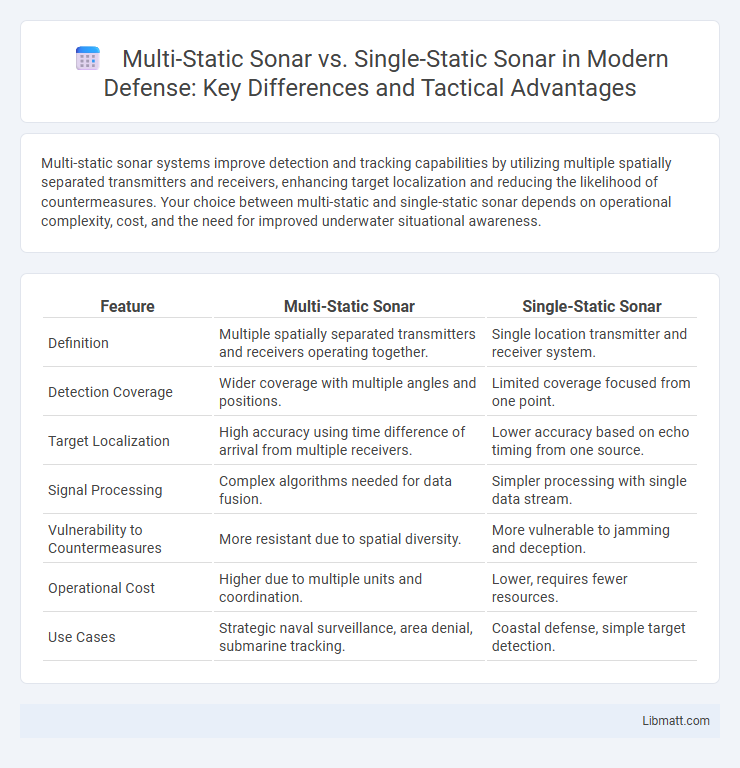Multi-static sonar systems improve detection and tracking capabilities by utilizing multiple spatially separated transmitters and receivers, enhancing target localization and reducing the likelihood of countermeasures. Your choice between multi-static and single-static sonar depends on operational complexity, cost, and the need for improved underwater situational awareness.
Table of Comparison
| Feature | Multi-Static Sonar | Single-Static Sonar |
|---|---|---|
| Definition | Multiple spatially separated transmitters and receivers operating together. | Single location transmitter and receiver system. |
| Detection Coverage | Wider coverage with multiple angles and positions. | Limited coverage focused from one point. |
| Target Localization | High accuracy using time difference of arrival from multiple receivers. | Lower accuracy based on echo timing from one source. |
| Signal Processing | Complex algorithms needed for data fusion. | Simpler processing with single data stream. |
| Vulnerability to Countermeasures | More resistant due to spatial diversity. | More vulnerable to jamming and deception. |
| Operational Cost | Higher due to multiple units and coordination. | Lower, requires fewer resources. |
| Use Cases | Strategic naval surveillance, area denial, submarine tracking. | Coastal defense, simple target detection. |
Introduction to Sonar Technology
Multi-static sonar systems employ multiple spatially separated transmitters and receivers to enhance detection accuracy and reduce blind zones, outperforming single-static sonar that relies on a single transmitter-receiver pair. These advanced configurations improve target localization through diverse signal paths and cross-correlation techniques, making them ideal for complex underwater environments. Single-static sonar remains simpler and more cost-effective, typically used for basic imaging and navigation tasks.
Defining Mono-static and Multi-static Sonar Systems
Mono-static sonar systems operate with a single platform that transmits and receives acoustic signals, providing localized detection and tracking capabilities. Multi-static sonar systems utilize multiple spatially separated transmitters and receivers, enhancing detection range, resolution, and target classification by analyzing diverse acoustic paths. Your sonar strategy can benefit from multi-static configurations by improving situational awareness and reducing vulnerability to countermeasures.
Key Components of Single-static Sonar
Single-static sonar consists of a single sonar system with a transmitter and receiver co-located, relying on one platform for both emitting acoustic signals and receiving echoes. Key components include a transducer that converts electrical energy into sound waves, a receiver to detect returning echoes, and signal processing units to interpret underwater objects or terrain. Your effective use of single-static sonar depends on the precision of these integrated components and their ability to operate cohesively in one system.
Fundamentals of Multi-static Sonar Configurations
Multi-static sonar configurations employ multiple spatially separated transmitters and receivers to enhance target detection and localization accuracy compared to single-static sonar, which relies on co-located or fixed transmitter-receiver pairs. This approach improves coverage and detection capabilities by leveraging diverse acoustic paths and bistatic or multistatic scattering geometry, reducing the likelihood of target stealth and signal interference. Understanding these fundamental differences allows you to optimize sonar system design for complex underwater environments and operational requirements.
Operational Differences Between Multi-static and Single-static Sonar
Multi-static sonar systems deploy multiple spatially separated transmitters and receivers, enhancing target detection and localization accuracy through diverse signal paths, whereas single-static sonar relies on co-located transmitter-receiver pairs, limiting spatial coverage and resolution. The operational advantage of multi-static sonar lies in its ability to mitigate acoustic shadow zones and counteract target maneuvering by exploiting geometric diversity, improving detection probability in complex underwater environments. Single-static sonar systems typically offer simpler deployment and lower processing requirements but lack the robustness and spatial awareness inherent to multi-static configurations.
Detection Range and Coverage Capabilities
Multi-static sonar systems significantly enhance detection range by exploiting multiple spatially separated transmitters and receivers, enabling better signal-to-noise ratios and resilience to target maneuvering. Coverage capabilities improve with multi-static sonar through expanded spatial diversity, allowing for simultaneous monitoring of larger areas and reducing blind zones compared to single-static sonar setups. Single-static sonar systems, limited by a single source-receiver pair, typically offer reduced detection range and coverage, especially in complex underwater environments where multipath and clutter effects are prevalent.
Advantages of Multi-static Sonar Systems
Multi-static sonar systems offer enhanced target detection and localization accuracy by employing multiple spatially separated transmitters and receivers, improving coverage and reducing blind spots compared to single-static sonar. The increased spatial diversity in multi-static configurations improves signal-to-noise ratios and resilience against countermeasures like jamming or stealth technology. These systems enable more precise tracking of underwater objects in complex acoustical environments, enhancing situational awareness for naval operations and underwater surveillance.
Challenges and Limitations of Both Sonar Types
Multi-static sonar systems face challenges such as complex signal processing requirements, synchronization issues among multiple platforms, and increased vulnerability to environmental noise and interference. Single-static sonar systems, while simpler, suffer from limited spatial coverage and reduced detection reliability under certain acoustic conditions. Your choice between these sonar types must consider factors like operational complexity, data fusion needs, and the specific underwater environment where detection accuracy is critical.
Applications in Modern Naval and Civilian Operations
Multi-static sonar systems improve target detection and tracking by using multiple spatially separated transmitters and receivers, enhancing coverage and reducing stealth in modern naval operations. These systems are crucial for anti-submarine warfare, mine detection, and maritime surveillance, offering superior detection capability compared to single-static sonar. In civilian applications, multi-static sonar aids in underwater mapping, environmental monitoring, and offshore infrastructure inspection, benefiting from its increased spatial resolution and robustness against acoustic noise.
Future Trends in Sonar Technology
Multi-static sonar systems, utilizing multiple spatially separated transmitters and receivers, offer enhanced target detection and classification capabilities compared to single-static sonar by improving spatial diversity and reducing detection blind spots. Future trends emphasize integrating artificial intelligence and machine learning algorithms to process large volumes of multi-static sonar data in real-time, increasing accuracy in complex underwater environments. Advances in low-power electronics and autonomous underwater vehicles (AUVs) are expected to further expand the deployment and operational efficiency of multi-static sonar networks in maritime surveillance and defense applications.
multi-static sonar vs single-static sonar Infographic

 libmatt.com
libmatt.com